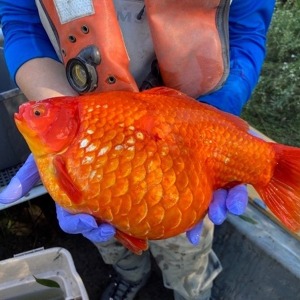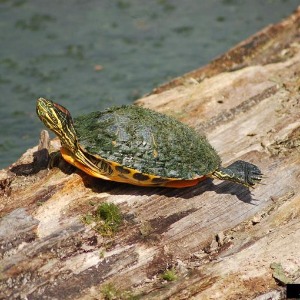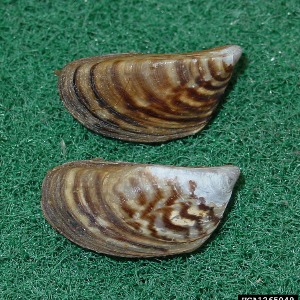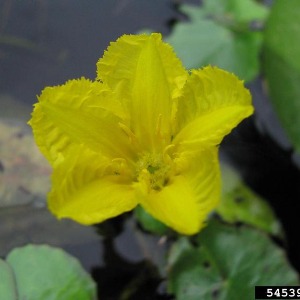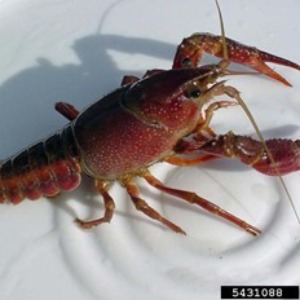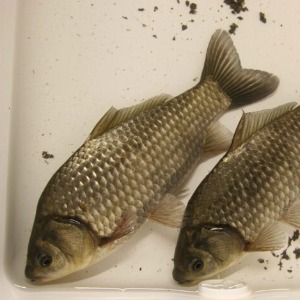Are you a pet owner? Don’t Let It Loose!
Owning a pet or an aquarium can be an exciting and fulfilling hobby – but it also comes with responsibility!
Domestic pets like fishes, invertebrates, aquatic plants, reptiles, amphibians, or mammals can become invasive when released into natural environments.
Loose pets can have negative impacts on natural ecosystems by spreading disease, outcompeting native species for resources, preying on native species, contributing to habitat degradation as well as increasing pressure on endangered and/or threatened species at risk.
Even when a pet is released based on moral and compassionate grounds, not only the ecological integrity of that ecosystem is being jeopardized, but the pet may not be able to adapt to the new environment leading to a potentially tragic death because of their inability to cope with natural conditions such as temperature, food availability, or predators.
Nonetheless, pet owners bear the difficult responsibility of seeing their animals through to the end of their lives.
The best practice in preventing the spread of invasive species is to not let it loose!
On this page:
Pathways related to species spread
Intentional vs. unintentional release
Jurisdiction-specific restrictions
Considerations before buying a pet
- New pet checklist
What’s the problem?
What is an invasive species and why can my pet become invasive?
Invasive species pose ecological, social, and economic challenges by accelerating biodiversity loss and altering the composition of natural ecological structures. They are considered one of Canada’s greatest threats to the survival of wild animal and plant life, and the pet release pathway creates additional pressure on ecological communities.
Species can become invasive when they are introduced to new environments outside of their natural range, potentially leading to negative impacts where newly introduced.
Examples of exotic species or pets that can become invasive when released into the wild include Goldfish, Red-Eared Sliders, Yellow Floating Heart, Red Swamp Crayfish, and even Zebra Mussel and Quagga Mussel.
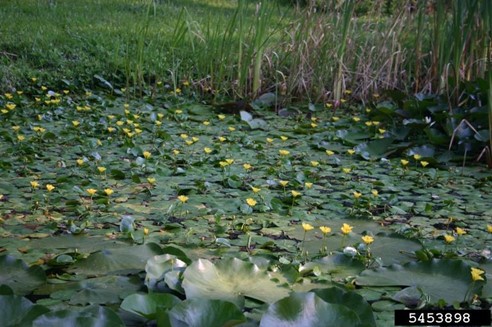
Pathways related to species release
Pathways are routes by which invasive species are transferred from one ecosystem to another. The pet release pathway is a significant concern for native species, especially those at risk. Intentional and unintentional releases can occur in a number of forms:
Pet releases
Domestic pets including fishes, invertebrates, frogs, turtles, mammals, or aquatic plants may be released into the wild when their owners may no longer wish or want to care for them. This could include, for instance, Goldfish, Red-Eared Sliders, Koi, or rabbits to name a few. This is a pathway of introduction for species that have the capacity to become invasive.
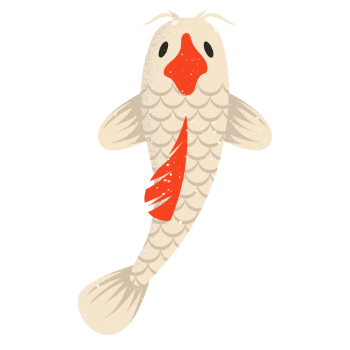
Water garden
Exotic plant species like Yellow Floating Heart, European Water Chestnut, or Flowering Rush may escape from water gardens as a result of flooding events, via connected waterways or through disposal. Gardens should be designed to hold contents without the possibility of releasing them and regular monitoring should take place to avoid unintentional escapes. An architecturally sound water garden enclosure is also necessary in preventing the release of common water garden fish like Koi. When disposing of exotic or aquarium plants, do not compost them or dispose of them close to water.
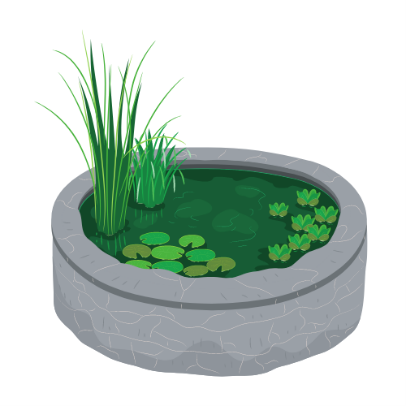
Live food
People may release live food in an effort to liberate them from the food market. Unfortunately, while often done with good intentions, this can be harmful to both the natural environment and to the animal itself which may not have the ability to survive in foreign habitats. This pathway could include the release of species like Red Swamp Crayfish.

Bait
Live bait release can be a form of invasive species introduction. Species like Round Goby, or Grass, Silver, Bighead or Black Carp, may be mistaken as bait fish and subsequently released. Even if bait is not alive, it may still spread diseases or pathogens to other species present in waterways and therefore it is important to not dispose live bait into waterways external to the one where it was collected. Live bait is prohibited or restricted in some Canadian provinces so ensure you are in compliance with these regulations when fishing.
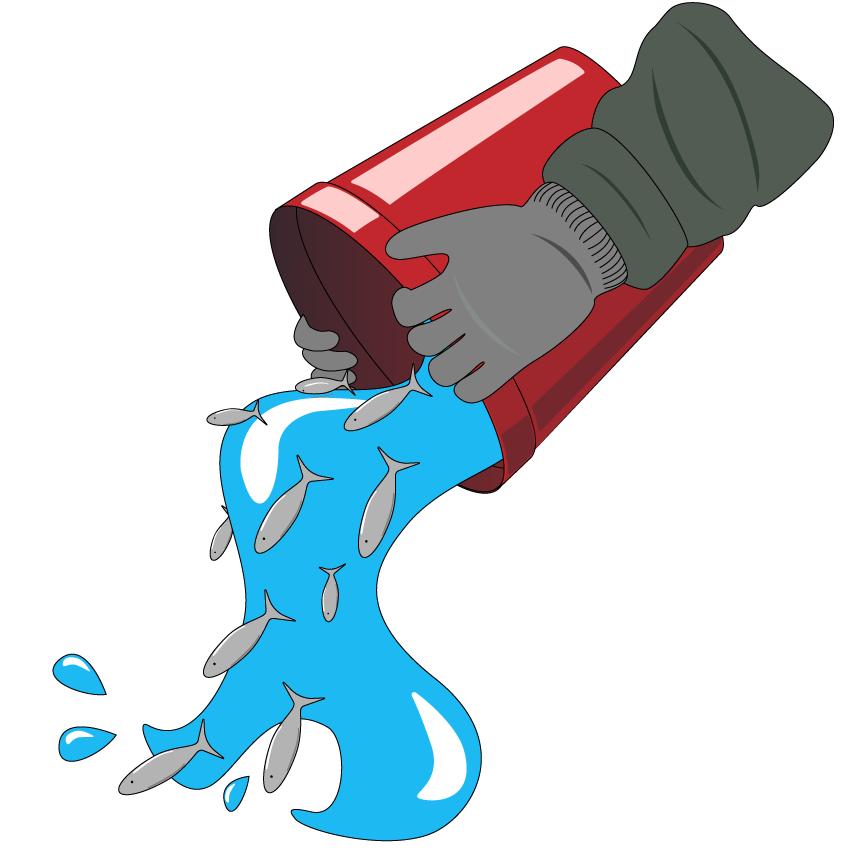
Sportfish
Releasing sportfish, like Tench, into waterways for the purpose of fishing can lead to ecological disturbances and threaten native species. Sportfish may be more successful than native fish species in their quest for food, and problems generated from introduced species to the natural environment outweighs the benefits for anglers.
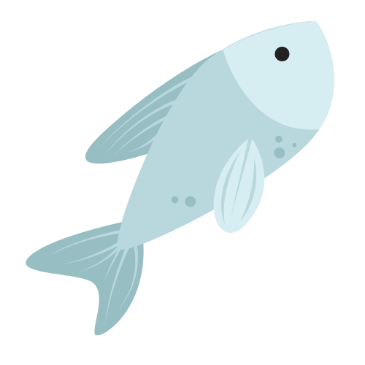
E-commerce
The ability to easily buy and sell live organisms online provides a simple and often seamless means of importing exotic organisms into Canada. Issues surrounding e-commerce as a pathway for invasive species spread include inaccurate or unclear taxonomic information provided by sellers, limited consumer knowledge regarding items purchased and associated risk, challenges regarding the regulation of this pathway, and the subsequent release or escape of these organisms into Canada’s natural environments. For instance, moss balls, a common aquarium species, have been previously found to carry Zebra and Quagga Mussel that were unintentionally purchased by owners.

Intentional vs. unintentional release
Species may be spread either intentionally or unintentionally via aquaculture trade. Goldfish or Red-Eared Sliders, for instance, may be released intentionally into natural ponds or waterways by their often-well-intentioned owners. Having been released in ponds or connecting waterways, Goldfish now have established populations in each of the Canadian provinces and in regions across the United States except Alaska. In Ontario, they are established in both the north shore of Lake Erie and the west end of Lake Ontario. The province of Alberta has also verified the presence of Goldfish or Koi fish in over 70 different locations.
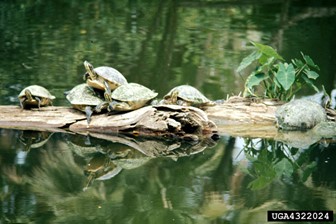
Goldfish and Red-Eared Sliders are almost exclusively released into urban ponds and waterways by well-meaning pet owners. Red-Eared Sliders are not adapted to harsh Canadian winters and may not even survive long-enough to enjoy their newfound freedom. Red-Eared Sliders can spread to new locations and Goldfish may even make long-distance jumps when carried by birds of prey like an Eagle or Hawk.
Alternatively, invasive species may be spread unintentionally in their trade pathways. Zebra and Quagga Mussels may attach to moss balls which are sold in the aquaculture trade and may be unintentionally introduced to waterways along their route or with disregarded moss balls. Zebra and Quagga Mussels can outcompete species at risk such as Fawnsfoot, Threehorn Wartyback, and Pugnose Minnow, for habitat and food resources.
Ecological impacts
The ecological impacts of pet releases can be broad, namely through increasing competition for resources like food and habitat and exacerbating the overall stability and capacity of the natural community. In aquatic environments, some exotic fishes and plants species may spread quickly and form dense and overpopulated habitats that are difficult to manage once established.
Hamilton Harbour in Ontario, for instance, has been reported to have overcrowded ponds of Goldfish that may have forced other native species to relocate. Cities in Alberta including Lethbridge and Red Deer have also seen storm ponds swell with large populations of Goldfish. Species that may become well established like Goldfish, are very tolerant of poor environmental conditions which facilitates their success in new environments.
Some of the non-species-specific ecological impacts of pet release include:
- Changing native species composition and diversity in a landscape resulting in altered ecosystem functions.
- Causing infection, wounding, introducing parasites, or killing native species.
- Eliminating or greatly reducing species populations that are only found in one geographic location (endemic).
- Reducing biodiversity by outcompeting native species.
- Reducing critical habitats that species at risk need to survive.
The ecological impacts of pet release can be especially harmful to species at risk. Loose pets may amplify the challenges already faced by many at risk species including limiting access to food, habitat destruction, and competition for space.

Socioeconomic impacts
The impacts of loose pet species can also extend to socioeconomic levels. Recreational water users like anglers, boaters, or beachgoers may see a decrease in water quality because of newly introduced species. This can reduce the ability to enjoy these activities or benefit from them economically.
Management of invasive species is also costly and imposes a significant financial burden on all levels of government. Industry losses attributed to decreased water quality and intake of resources may also occur including decreases in commercial fishing opportunities.
From aquarium owners to recreational anglers, pet release can have broad negative consequences.
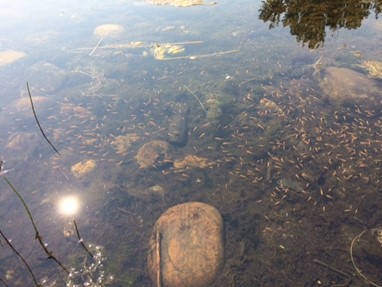
Jurisdiction-specific restrictions
Aquatic invasive species are regulated both federally and provincially in Canada.
Under federal law, it is illegal for any person to introduce an aquatic species into a particular region or body of water frequented by fish where it is not indigenous unless otherwise authorized to do so.
In Ontario, species that may be attributed to the aquaculture trade like Golden Mussel, Killer Shrimp, European Water Chestnut, among others, are prohibited. This means it is illegal to import, possess, deposit, release, transport, breed/grow, buy, sell, lease or trade them. You can find a comprehensive list of prohibited species to own here.
Regulated invasive species in Manitoba can be found here. Regulated species in Manitoba include Prussian Carp, Chinese Mystery Snail, Zebra and Quagga Mussel, Red Swamp Crayfish, and Yellow Floating Heart. Possession, transportation, or depositing of invasive species is subject to respective infractions of up to $1,296 for individuals.
Regulated invasive species in Saskatchewan can be found here. Regulated species in Saskatchewan include Zebra and Quagga Mussel and Round Goby.
Regulated invasive species in Alberta can be found here. Regulated species in Alberta include Tench, Zebra and Quagga Mussel, and Yellow Floating Heart. Release of live fish into Alberta’s lakes or rivers can lead to fines of up to $100,000.
Regulated species in British Columbia can be found here. Regulated species in British Columbia include Zebra and Quagga Mussel, Tench, and Round Goby. It is illegal to possess an individual aquatic invasive species and a person possesses an aquatic invasive species individual must prevent it from breeding. Releasing an alien species is subject to a minimum fine of $2,500.
In Canada, federally regulated invasive species include Zebra and Quagga Mussels and Sea Lamprey among others. You can find the regulations here.
Species profiles of species that may be prone to release
Several species may be prone to release by pet owners which can lead to negative impacts on natural ecosystems. Click the images below to view their species profiles.
Considerations before buying a pet
Preventing the spread of invasive species starts with education. Before buying a pet, consider the following:
- Conduct research on the species prior to purchasing it and know information related to whether it is legal to own it in Canada, if the seller is a reputable retailer, the pet’s life expectancy, and the necessary care requirements for the pet. Have a look at our checklist below!
- Ensure that ponds and aquariums are contained and have no potential to unintentionally release species into the wild. Be mindful that any water released from aquariums, ponds or water gardens is done on land and away from household drains, sewers or other bodies of water.
- When disposing of your pet or plant, ensure that it is done with caution. If your pet dies, don’t flush it down the toilet; bury it instead so it can’t spread disease. Dry and freeze plants in tightly sealed bags before throwing them in the trash and do not compost them. Try to choose a native species as a precautionary measure.
- Be aware of the ethical commitment of pet ownership. Pet ownership bears the responsibility of caring for another living being, which is a serious obligation. Take the time to decide the right pet for you or your family to care for. The timeline of this decision can extend as long as decades and taking the responsibility of caring for another life seriously will create a more meaningful environment than an impulsive decision to purchase a pet without hesitation.
New pet checklist:
- Have you researched your pet? Are you aware of their expected lifestyle and are you prepared if the pet behaves differently than you expect?
- Is the seller reputable?
- Is the pet captive-bred or wild caught? Captive-bred pets are far more appropriate for a noivce keeper.
- Do you know the requirements of your new pet to thrive under your care?
- Do you have the time to keep up with the daily maintenance levels required by this pet?
- What is the life expectancy of the pet? Are you able to care for this pet throughout its expected lifespan?
- Are you prepared to provide the necessary care requirements for the full estimated lifespan of the pet?
- Do you have other commitments like employment or family that may make it difficult to own a pet?
- Does your lifestyle give you the financial means necessary to care for the pet?
- Are you prepared to cover routine and emergency veterinary expenses?
- Do you have or are you able to purchase all the accessories that are necessary for owning your pet?
- Do you have friends or family who are able to care for your pet in the event that you are not able to?
- Do you have space for your pet in your home? Are you aware of and prepared for the growth of your pet?
- Is this pet legal to keep in Canada and your jurisdiction?
Alternatives to release
Reducing the spread of domestic pets that become invasive is as simple as not letting them loose in the wild. If you can no longer care for your pet, it’s essential that you don’t release it. Here are some alternatives:
- Contact the retailer for advice. They may be willing to facilitate a possible return or surrender of your pet. They may also be able to provide you with advice on how to improve your relationship with your pet so that you may decide not to rehome it.
- Contact another aquarium, pond owner or pet owner and inquire whether they would be interested in adopting your pet. You can research groups on social media, or on online platforms, and see if a credible and responsible person is willing to own your pet.
- Donate it to a local aquarium society or school if they are interested in studying or having your pet for learning purposes.
- If all other options have been exhausted, consult a veternarian for a safe, and humane euthanasia of your pet. Euthanasia literally means “good death,” and true euthanasia – delivered by an intravenous injection of sodium pentobarbital – is painless, quick, and dignified way to give an animal a peaceful release from this world. Unfortunately, individual euthanasia is an option that better protects larger ecosystems that may be full of entire communities of flora and fauna.
E-Commerce
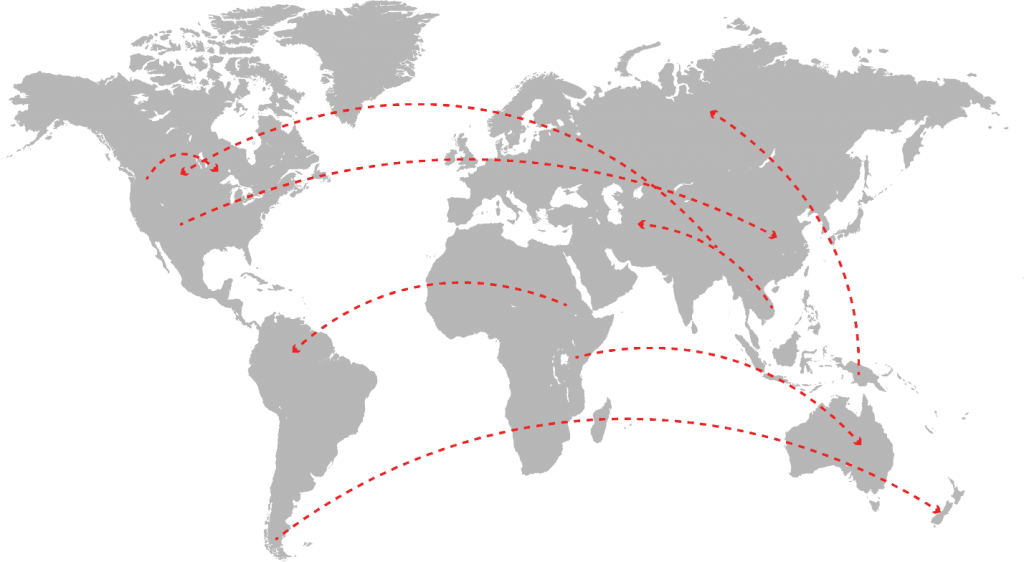
E-commerce is a pathway of invasive species spread that is becoming more prevalent as sales transition to online domains. Unfortunately, regulations surrounding the sale of animals online are limited which allows for individual retailers to sell product without informing their buyers of the potential dangers of these species becoming invasive.
Informed consumerism is the best defense against spreading invasive species via the e-commerce pathway.
When purchasing plants or animals for your aquarium, be an informed consumer! Here is a checklist for things to look for:
- Is the species being sold by a reputable retailer?
- Is this species legal in my region?
- Is this species native to my region?
- Will I be keeping this pet in a safely enclosed location where it cannot escape?
- How will this species be transported and is there any chance of it escaping?
- Are there other species that may hitchhike on the species I’m purchasing?
Reporting
If you think you have found or spotted an invasive species, you can report your sighting in a few different ways:
- Anywhere in Canada, you can report through EDDMapS at https://www.eddmaps.org/.
- In Ontario: Invading Species Hotline is 1-800-563-7711
- In Alberta: https://www.eddmaps.org
- If you suspect any of these species, please report them promptly, either through the AIS hotline at 1-855-336-BOAT (2628) or on EDDMapS Alberta.
- In British Columbia: https://bcinvasives.ca/report
- In Manitoba: https://www.gov.mb.ca/stopais/ais_reporting.html
- Report new AIS sightings to the Aquatic Invasive Species hotline at 1-87-STOP AIS-0 (1-877-867-2470) or online here.
- In Saskatchewan: https://www.saskatchewan.ca/residents/environment-public-health-and-safety/wildlife-issues/invasive-species/reporting-and-tracking-invasive-species
- If the occurrence is ongoing or taking place now, call the TIPP line at 1-800-667-7561. Or report it online via TipWeb: http://www.environment.gov.sk.ca/tipweb.
- For other provincial or regional resources, consult our Reporting a Sighting page.
- Also consider downloading iNaturalist to join a broader community of citizen scientists.

